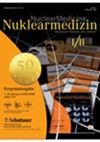Cisplatin - A more Efficient Drug in Combination with Radionuclides?
IF 1
4区 医学
Q4 RADIOLOGY, NUCLEAR MEDICINE & MEDICAL IMAGING
引用次数: 3
Abstract
AIM The combination of conventional chemotherapeutic drugs with radionuclides or external radiation is discussed for a long period of time. The major advantage of a successful combination therapy is the reduction of severe side effects by decreasing the needed dose and simultaneously increasing therapeutic efficiency. METHODS In this study, pUC19 plasmid DNA was incubated with the cytostatic drug cisplatin and additionally irradiated with 99mTc, 188Re and 223Ra. To verify the contribution of possibly excited platinum atoms to the emission of Auger electrons we determined DNA damages, such as single- and double strand breaks. RESULTS The threshold concentration value of cisplatin, which was tolerated by pUC19 plasmid DNA was determined to be 18-24 nM. Nevertheless, even at higher dose values (>100 Gy) and simultaneous incubation of cisplatin to 200 ng plasmid DNA, no significant increase in the number of induced single- and double-strand breaks was obtained, compared to the damage solely caused by the radionuclides. CONCLUSION We thereby conclude that there is no direct dependence of the mechanism of strand break induction to the absence or presence of platinum atoms attached to the DNA. Reported increasing DNA damages in therapy approaches on a cellular level strongly depend on the study design and are mainly influenced by repair mechanisms in living cells. Nevertheless, the use of radioactive cisplatin, containing the Auger electron emitter 191Pt, 193mPt or 195mPt, is a bright prospect for future therapy by killing tumor cells combining two operating principles: a cytostatic drug and a radiopharmaceutical at the same time.顺铂-与放射性核素联合使用更有效?
目的常规化疗药物与放射性核素或外照射的联合应用一直是人们讨论的问题。成功的联合治疗的主要优点是通过减少所需剂量来减少严重的副作用,同时提高治疗效率。方法将pUC19质粒DNA与细胞抑制药物顺铂孵育,外加99mTc、188Re和223Ra辐照。为了验证可能被激发的铂原子对俄歇电子发射的贡献,我们测定了DNA损伤,如单链和双链断裂。结果pUC19质粒DNA耐受顺铂的阈值为18 ~ 24 nM。然而,即使在更高的剂量值(bbb100 Gy)下,顺铂与200 ng质粒DNA同时孵育,与放射性核素单独引起的损伤相比,诱导的单链和双链断裂的数量也没有显著增加。结论:DNA上是否存在铂原子与诱导链断裂的机制没有直接关系。据报道,细胞水平治疗方法中DNA损伤的增加很大程度上取决于研究设计,主要受活细胞修复机制的影响。然而,使用含有俄歇电子发射器191Pt、193mPt或195mPt的放射性顺铂,结合细胞抑制剂和放射性药物两种工作原理同时杀死肿瘤细胞,是未来治疗的一个光明前景。
本文章由计算机程序翻译,如有差异,请以英文原文为准。
求助全文
约1分钟内获得全文
求助全文
来源期刊
CiteScore
1.70
自引率
13.30%
发文量
267
审稿时长
>12 weeks
期刊介绍:
Als Standes- und Fachorgan (Organ von Deutscher Gesellschaft für Nuklearmedizin (DGN), Österreichischer Gesellschaft für Nuklearmedizin und Molekulare Bildgebung (ÖGN), Schweizerischer Gesellschaft für Nuklearmedizin (SGNM, SSNM)) von hohem wissenschaftlichen Anspruch befasst sich die CME-zertifizierte Nuklearmedizin/ NuclearMedicine mit Diagnostik und Therapie in der Nuklearmedizin und dem Strahlenschutz: Originalien, Übersichtsarbeiten, Referate und Kongressberichte stellen aktuelle Themen der Diagnose und Therapie dar.
Ausführliche Berichte aus den DGN-Arbeitskreisen, Nachrichten aus Forschung und Industrie sowie Beschreibungen innovativer technischer Geräte, Einrichtungen und Systeme runden das Konzept ab.
Die Abstracts der Jahrestagungen dreier europäischer Fachgesellschaften sind Bestandteil der Kongressausgaben.
Nuklearmedizin erscheint regelmäßig mit sechs Ausgaben pro Jahr und richtet sich vor allem an Nuklearmediziner, Radiologen, Strahlentherapeuten, Medizinphysiker und Radiopharmazeuten.

 求助内容:
求助内容: 应助结果提醒方式:
应助结果提醒方式:


